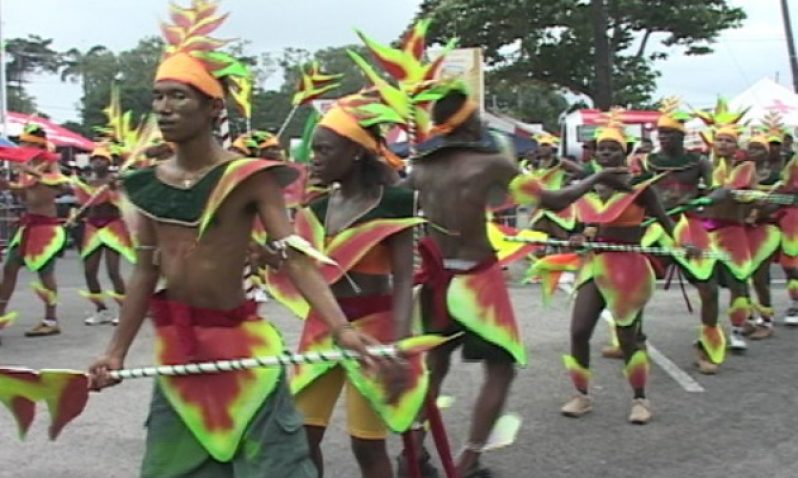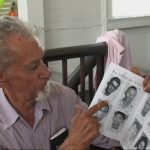MAHSRAMANI, a popular cultural event full of glitter, gyration and colour, is held each year in Guyana to commemorate the country’s Republic Anniversary, which was achieved in 1970.
The festival, which has as its main attraction the February 23 costume and float parade in the capital, is preceded by several activities in the various regions. In 2002, Mashramani was themed, “Colourful and true in Mash 2002”; and in 2004, “Unity beauty and more in 2004”.
In 2006, the festival was held under the theme, “Showcasing a cultural mix in 2006”; followed by “A cultural invasion in 2007” and “Let’s unite and celebrate Mashramani in 2008.”
This year (2009), the festival will be celebrated under the theme, “One Dream, One Celebration, One Design in 2009”. Mashramani falls under the ambit of the Ministry of Culture, Youth and Sport through its spearheading body, the Mashramani Secretariat, located on Middle Street Georgetown.
First Mashramani Organizers
Mashramani began in the town that is today known as Linden in Region Ten following independence in 1966. The Jaycees International Chapter, an organisation with a mandate to promote community development in Mackenzie, was formed; and led by its first president, Jeff Harris, the organisation came up with the idea of an independence celebration in the town.
Subsequently, several fundraising activities were hosted, with the main attraction being the crowning of an Independence Queen, an event whereby the various departments of the then Demerara Bauxite Company (DEMBA) would sponsor one of its female employees. The employee would then solicit support from the community members, who, by their votes, would decide the winner.
As the event grew in popularity, the organisers decided to move it from an ‘Independence Queen’, to an ‘Independence Carnival’, which saw new features and participants.
The first such event was held in 1969, and was hailed a success. Jimmy Hamilton, who was the event’s Public Relations Officer (PRO) for a number of years, said in an exclusive interview with the Government Information Agency (GINA) that it was described in a newspaper article as “Carnival coming to Guyana”.
How the name Mashramani emerged
During the same year, Guyana was also gearing for Republican status, and in 1970, a decision was taken not to have an independence carnival in Mackenzie. Hamilton recalled that the then government had set out on a socialist agenda, resulting in a restructuring of many of the country’s traditional events.
Terms such as ‘monarchy’, ‘crowning of queen’ and ‘carnival’ had to be replaced, and the search began for patriotic names.
With the first Republic Anniversary celebration fast approaching, organisers of the Independence Carnival were prompted to transform the event into a national celebration involving participation from across the country.
Former West Indies cricketer, Basil Butcher, one of the organising members, was tasked with travelling to the three Counties (Berbice, Demerara and Essequibo), soliciting interests, while Hamilton and several others were required to come up with a new name for the national celebrations.
Hamilton said the search for a name was extensive and tiresome, as it entailed research from the University of Guyana, the National Archives and several other intellectual sources, which, unfortunately, proved futile.
With time running out, the organisers’ last resort was to seek help from the Amerindians.
Alan Fiedtkou, an Amerindian who worked in the geological department of the bauxite company and lived in the ‘Interior’, was called in on the research project.
Hamilton recalled distinctly the stories told by Fiedtkou about various Amerindian cultural celebrations, one of which was Mashramani. It was a celebration which usually goes for days during a wedding, or after the end of hard labour.
After hearing the story, Hamilton said the organisers felt that it was the perfect patriotic name for the celebration.
“When we took it back to our executive committee, we said, ‘This is the story; this is the celebration after a complete cooperative effort because it involves the effort of everyone within these communities and we are the cooperative republic of Guyana,’” Hamilton said.
The idea was immediately taken to Adrian Thompson, a District Commissioner who worked in the ‘Interior’ among several Amerindians; and following days of extensive verification, Thompson advised that the event should carry the name, “Mashramani”.
Hamilton said “Mashramani” quickly became popular, and the celebration attracted the sponsorship of the Demerara Distillers Limited (DDL).
From Linden to Georgetown
After Guyana gained Republican status, Mashramani was taken to Georgetown for the first time in 1972, following the then government’s call for it to travel to other parts of the country in keeping with nationalistic principles.
Hamilton disclosed that the Region Ten residents were not pleased with the idea to move Mashramani out of the Region, and that same year, the Bauxite Company in Linden decided to mount a 500-strong band to visit Georgetown to showcase Region Ten, as it felt that it needed to remind the country that Mashramani was theirs.
Hamilton said Region Ten held the reputation as the first region to mount a band of that magnitude, and later influenced other groups, such as the Joint Services, to join the bandwagon.
“The task of putting together such as large contingent was not easy; we brought people from Kawkwani, Ituni, Everton, Mackenzie and Wismar,” Hamilton said.
Hamilton also recalled the period of the economic crisis in the early 1980s, which affected the flamboyance of Mashramani, because of the difficulty in importing colourful materials for the celebration, and the restoration period in the 1990s, and commended the efforts of former Minister of Culture, Youth and Sport, Ms Gail Teixeira.
Now 77 years old and a colleague of designer Don Gomes, Hamilton has never missed a Mashramani celebration since, and believes that it is a part of him.
“When we did Mashramani in Linden, the town profited tremendously, and it was the first time in Mackenzie that people enjoyed being there,” Hamilton said.
Mahsramani Today
Now under the helm of the Ministry of Culture, Youth and Sport, each year’s celebration features a calendar of events.
Members of the national and regional sub-committees are formed by the Mashramani Secretariat to organise events in the lead-up to the February 23 celebrations. These include a Mash Jamboree, Junior and Senior Calypso, Soca, Chutney, Steelband, Masquerade and Children’s competitions.
The competitions, particularly Calypso and Soca, have over the years become popular and highly competitive, as participants vie for the monarchy and attractive prizes.
Similar activities are hosted at the regional level, including church services, community clean-up campaigns, regional concerts, school debating and essay-writing competitions, day of sport and memorial services.
Major private companies such as the Guyana Telephone and Telegraph Company Ltd (GT&T), Banks DIH, Ansa McAl, and Digicel have, over the years, joined in the sponsorship and participation in Mashramani, making it bigger and better.
Each year, the festival has seen new additions, and this year is no exception, as an Inter-Neighbourhood Democratic Council competition for the best aesthetics, a child art and essay competition and an exhibition at the National Museum tracing the history and showcasing artifacts of the festival will be included.





.jpg)












